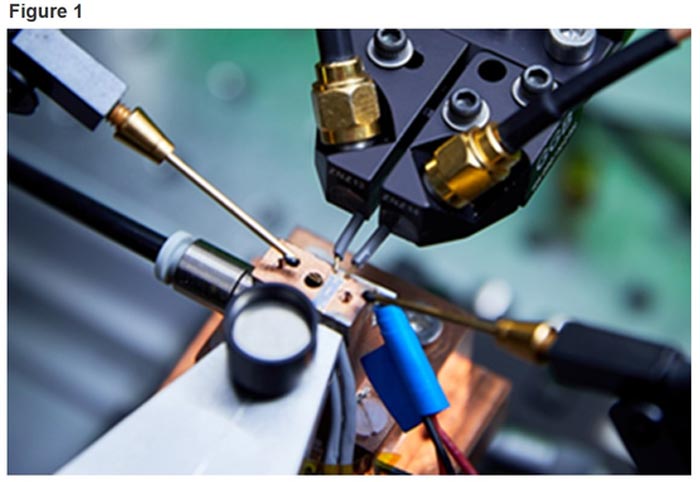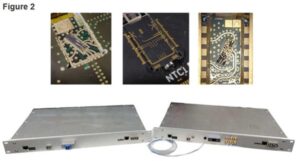Toshiba shrinks quantum key distribution technology to a semiconductor chip

Figure 1: A QKD chip under test at Toshiba’s Cambridge Research Laboratory
Credit: Toshiba Corporation
Toshiba develops world’s first QKD system based on quantum transmitter, receiver and random number generator chips; Quantum chips manufactured using standard semiconductor processes; Significant advance towards mass deployment of quantum communications.
Toshiba Europe Ltd today announced it has developed the world’s first chip-based quantum key distribution (QKD) system. This advance will enable the mass manufacture of quantum security technology, bringing its application to a much wider range of scenarios including to Internet of Things (IoT) solutions.
QKD addresses the demand for cryptography which will remain secure from attack by the supercomputers of tomorrow. In particular, a large-scale quantum computer will be able to efficiently solve the difficult mathematical problems that are the basis of the public key cryptography widely used today for secure communications and e-commerce. In contrast, the protocols used for quantum cryptography can be proven secure from first principles and will not be vulnerable to attack by a quantum computer, or indeed any computer in the future.
The QKD market is expected to grow to approximately $20 billion worldwide in FY2035*. Large quantum-secured fibre networks are currently under construction in Europe and South-East Asia, and there are plans to launch satellites that can extend the networks to a global scale. In October 2020, Toshiba released two products for fibre-based QKD, which are based on discrete optical components. Together with project partners, Toshiba has implemented quantum-secured metro networks and long-distance fibre optic backbone links in the UK, Europe, US and Japan.
Manufacturing advances
For quantum cryptography to become as ubiquitous as the algorithmic cryptography we use today, it is important that the size, weight and power consumption are further reduced. This is especially true for extending QKD and quantum random number generators (QRNG) into new domains such as the last-mile connection to the customer or IoT. The development of chip-based solutions is essential to enabling mass market applications, which will be integral to the realisation of a quantum-ready economy.

Credit: Toshiba Corporation
Toshiba has developed techniques for shrinking the optical circuits used for QKD and QRNG into tiny semiconductor chips. These are not only much smaller and lighter than their fibre optic counterparts, but also consume less power. Most significantly, many can be fabricated in parallel on the same semiconductor wafer using standard techniques used within the semiconductor industry, allowing them to be manufactured in much larger numbers. For example, the quantum transmitter chips developed by Toshiba measure just 2x6mm, allowing several hundred chips to be produced simultaneously on a wafer.
Andrew Shields, Head of Quantum Technology at Toshiba Europe, remarked, “Photonic integration will allow us to manufacture quantum security devices in volume in a highly repeatable fashion. It will enable the production of quantum products in a smaller form factor, and subsequently allow the roll out of QKD into a larger fraction of the telecom and datacom network.”
Taro Shimada, Corporate Senior Vice President and Chief Digital Officer of Toshiba Corporation comments, “Toshiba has invested in quantum technology R&D in the UK for over two decades. This latest advancement is highly significant, as it will allow us to manufacture and deliver QKD in much larger quantities. It is an important milestone towards our vision of building a platform for quantum-safe communications based upon ubiquitous quantum security devices.”
Part of this work was funded by the Innovate UK Collaborative R&D Project AQuaSeC, through the Industrial Strategy Challenge Fund. The details of the advancement are published in the scientific journal, Nature Photonics.
Technical Summary
QKD systems typically comprise a complex fibre-optic circuit, integrating discrete components, such as lasers, electro-optic modulators, beam-splitters and fibre couplers. As these components are relatively bulky and expensive, the purpose of this work was to develop a QKD system in which the fibre-optic circuit and devices are written in millimetre scale semiconductor chips.
Toshiba has developed the first complete QKD prototype in which quantum photonic chips of different functionality are deployed. Random bits for preparing and measuring the qubits are produced in quantum random number generator (QRNG) chips and converted in real-time into high-speed modulation patterns for the chip-based QKD transmitter (QTx) and receiver (QRx) using field-programmable gate arrays (FPGAs). Photons are detected using fast-gated single photon detectors. Sifting, photon statistics evaluation, time synchronisation and phase stabilisation are done via a 10 Gb/s optical link between the FPGA cores, enabling autonomous operation over extended periods of time. As part of the demonstration, the chip QKD system was interfaced with a commercial encryptor, allowing secure data transfer with a bit rate up to 100 Gb/s.
To promote integration into conventional communication infrastructures, the QKD units are assembled in compact 1U rackmount cases. The QRx and QTx chips are packaged into C-form-factor-pluggable-2 (CFP2) modules, a widespread form-factor in coherent optical communications, to ensure forward compatibility of the system with successive QKD chip generations, making it easily upgradeable. Off-the-shelf 10 Gb/s small-form-factor pluggable (SFP) modules are used for the public communication channels.
Taofiq Paraiso, lead author of the Nature Photonics paper describing the chip-scale QKD system, says: “We are witnessing with photonic integrated circuits a similar revolution to that which occurred with electronic circuits. PICs are continuously serving more and more diverse applications. Of course, the requirements for quantum PICs are more stringent than for conventional applications, but this work shows that a fully deployable chip-based QKD system is now attainable, marking the end of an important challenge for quantum technologies. This opens a wide-range of perspectives for the deployment of compact, plug-and-play quantum devices that will certainly strongly impact our society.”
*Toshiba’s long-term estimate based on short to mid-term estimates by research firms
About Toshiba
Toshiba Corporation leads a global group of companies that combines knowledge and capabilities from over 140 years of experience in a wide range of businesses – from energy and social infrastructure to electronic devices – with world-class capabilities in information processing, digital and AI technologies. These distinctive strengths support Toshiba’s continued evolution toward becoming an Infrastructure Services Company that promotes data utilization and digitization, and one of the world’s leading cyber-physical-systems technology companies. Guided by the Basic Commitment of the Toshiba Group, “Committed to People, Committed to the Future,” Toshiba contributes to society’s positive development with services and solutions that lead to a better world. The Group and its 120,000 employees worldwide secured annual sales surpassing 3.1 trillion yen (US$27.5 billion) in fiscal year 2020.
Find out more about Toshiba at https://www.global.toshiba/ww/outline/corporate.html
About Toshiba Europe Ltd, Cambridge Research Lab
The Cambridge Research Laboratory of Toshiba Europe Ltd conduct research on Computer Vision, Speech and Quantum Technologies. The Quantum Information Group is exploring the ultimate limit of Information Technology in which each bit is encoded on a single electron or photon. Notable past achievements include the first Quantum Cryptography system to operate over 100km of fibre, the first to operate with a secure key rate of 10 Mbit/sec and the first semiconductor light emitting diodes for single photons and entangled pairs. For further information on their work go to http://www.quantum.toshiba.co.uk
About the AQuaSeC Project
The AQuaSeC project is developing technologies for “quantum-safe” communications, which cannot be attacked by a quantum computer. An important aspect is to develop prototype systems with lower size, weight and power based on photonic chip technology. The project builds a complete supply chain, involving 15 project partners and is led by Toshiba Europe Ltd. It is funded by Innovate UK through the Industrial Strategy Challenge Fund.
Journal: Nature Photonics
DOI: 10.1038/s41566-021-00873-0
Media Contact
Daniel Migdal
Nelson Bostock Unlimited
daniel.migdal@nelsonbostock.com
All latest news from the category: Information Technology
Here you can find a summary of innovations in the fields of information and data processing and up-to-date developments on IT equipment and hardware.
This area covers topics such as IT services, IT architectures, IT management and telecommunications.
Newest articles

Innovative 3D printed scaffolds offer new hope for bone healing
Researchers at the Institute for Bioengineering of Catalonia have developed novel 3D printed PLA-CaP scaffolds that promote blood vessel formation, ensuring better healing and regeneration of bone tissue. Bone is…

The surprising role of gut infection in Alzheimer’s disease
ASU- and Banner Alzheimer’s Institute-led study implicates link between a common virus and the disease, which travels from the gut to the brain and may be a target for antiviral…

Molecular gardening: New enzymes discovered for protein modification pruning
How deubiquitinases USP53 and USP54 cleave long polyubiquitin chains and how the former is linked to liver disease in children. Deubiquitinases (DUBs) are enzymes used by cells to trim protein…



